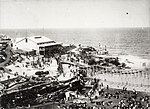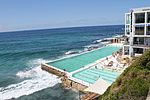Gay gang murders

The gay gang murders are a series of suspected anti-LGBT hate crimes perpetrated by large gangs of youths in Sydney, between 1970 and 2010, with most occurring in 1989 and 1990. The majority of these occurred at local gay beats, and were known to the police as locations where gangs of teenagers targeted homosexuals and trans individuals. In particular, many deaths are associated with the cliffs of Marks Park, Tamarama, where the victims would allegedly be thrown or herded off the cliffs to their deaths. As many as 88 gay men were murdered by these groups in the period, with many of the deaths unreported, considered accidents or suicides at the time.Today a memorial to the victims is in Marks Park.
Excerpt from the Wikipedia article Gay gang murders (License: CC BY-SA 3.0, Authors, Images).Gay gang murders
Kenneth Street, Sydney Tamarama
Geographical coordinates (GPS) Address Nearby Places Show on map
Geographical coordinates (GPS)
| Latitude | Longitude |
|---|---|
| N -33.8984765 ° | E 151.2730416 ° |
Address
Kenneth Street
Kenneth Street
2026 Sydney, Tamarama
New South Wales, Australia
Open on Google Maps










